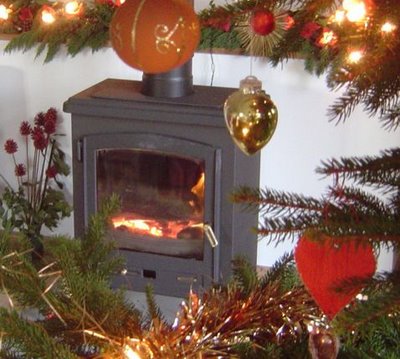
“People love chopping wood. In this activity one immediately sees results.” So said Albert Einstein! In my blog of 3rd December, I introduced you to Monsieur Crespel (above) the local bucheron (woodcutter/lumberjack) who I asked to help me safely bring to earth a hanging tree in our woods, a tree felled, perhaps by the wind, which got entangled in other trees and is especially dangerous, at least to debutant treefeller like myself. We remade our rendez-vous for yesterday, which turned out to be particularly cold (-3ºC).
Monsieur Crespel, a short man but impressively wide, arrived in his impossibly small car with a very large chainsaw and a remarkable absence of safety wear. After the formalities of a French “hello” and a short walk into the woodland, he set about the tree and in less than five minutes had it safely horizontal and, wielding his chainsaw with the swashbuckling gay abandon of Errol Flynn handling a sword, chopped it up into 50cm lengths, ready for our stove and then left me to it. Wood needs to be seasoned, so it looses its inherent moisture before it’s ready to burn, else loads of energy is used to boil off the water before it burns, so defeating the object somewhat and the gases given off during combustion are more polluting. Apparently, ash is the one wood one can burn green but I’ve never discovered why that should be so. (If you know, please leave a comment and tell me!)
I had (still have) a heavy cold and my intention was to work until lunchtime, then come home and get a hearty fire going in time to settle down next to the radio and listen to the footy during the afternoon. Trying to be clever in a time-and-motion sort of way, I thought it a good idea to reverse the van up as close to the entrance of the woodland as possible as I was bring the logs out a wheelbarrow at a time. By the time my van was full, the front-wheel drive Renault wouldn’t budge an inch in the mud: time-and-motion calculations slightly wrong! Luckily for me, I had my mobile phone with me and, just as luckily, my pig-farming and tractor-driving neighbour Paul had his with him as well. He arrived within ten minutes to drag me back to the tarmac.
Over coffee and some mince pies that Gabrielle had made, he told me that he was trying to mend a new piece of agricultural equipment he’d bought second-hand. It was sprayer attached to the back of a tractor with huge folding arms that refused to fold up having been unfolded. I felt duty-bound to offer a coup de main (helping hand) which is how I ended up in a freezing French field in the middle of December with a stinking cold trying to work out the hydraulics and electrics of a huge farm folding thing with only a technical manual in French for guidance. Despite getting hypothermic, I felt I couldn’t leave before the problem was solved and it was six o’clock, some three and a half hours later, when we finished by torchlight and the arms swung closed on command. By the time I returned home, the footy was over but all was not lost, as my team (Arsenal) had won 6 – 2, hooray!









